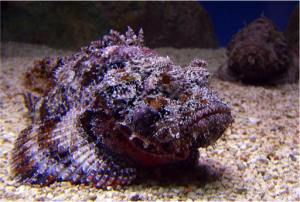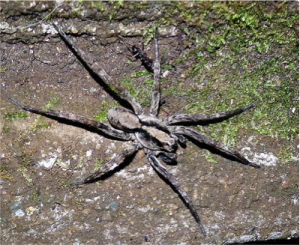Is that a rock or fish? A lizard or leaf? There are some animals that are great at playing hide and seek because they blend in with their surroundings. This trait is called camouflage. Come with me, Jungle Jim, as we find new creatures hidden all around us.
The Stonefish
 The stonefish has the perfect name because this creature is a fish that looks just like a stone. It has scaly brown or grey skin with crusty patches of red or orange. It looks like stones or corral found in the ocean. It uses its camouflage to hunt. It sits very still and hides while it waits for other smaller fish to swim by. Then, in a flash, it reaches out at snatches the fish.
The stonefish has the perfect name because this creature is a fish that looks just like a stone. It has scaly brown or grey skin with crusty patches of red or orange. It looks like stones or corral found in the ocean. It uses its camouflage to hunt. It sits very still and hides while it waits for other smaller fish to swim by. Then, in a flash, it reaches out at snatches the fish.
The stonefish is very poisonous and has sharp spines on its back. If it is stepped on it can be very painful.
Stonefish can also do something other fish can’t. It can live outside of the water for 24 hours. That’s one whole day!
The Great Grey Owl
The great grey owl lives among the trees in northern forests. It has brown spots and bars on its grey/white feathers. These markings help the owl blend in among the tree branches, especially in the bare trees in winter.
The great grey owl has incredible hearing. It finds mice and other little critters by listening to them tunnel beneath the snow. Then the owl swoops down silently and scoops up its prey for dinner.
Chameleons
Chameleons are great climbers and live in trees. They use their claws and tails to grip branches tightly. To stay hidden in the trees chameleons can change color to match their surroundings. While camouflage is one reason chameleons change color, they also change color to communicate. They change colors when angry or threatened, which means afraid of being attacked, or even to show dominance over other chameleons (that’s kind of like being the chameleon in charge). Some also change colors to absorb or reflect light, warming them up when it’s cool and cooling off when it is too warm. There are a lot of advantages to changing color!
There are 160 different kinds of chameleons. Most kinds of chameleons live on Madagascar which is an island off of the coast of Africa. This family of lizards includes the smallest lizard ever found. It is a chameleon that only grow to half an inch long. That’s about the size of a grown-up’s fingernail. Other chameleons can grow as long as two feet.
A chameleon uses its amazingly fast tongue to catch insects, similar to a frog. How fast can you stick your tongue in and out?
Wolf Spiders
 Wolf Spiders are drab gray and brown colors with spots and stripes. Their coloring helps them blend in to their surroundings on the ground. They often live in the leaves on forest floors or on the ground in meadows and swamplands.
Wolf Spiders are drab gray and brown colors with spots and stripes. Their coloring helps them blend in to their surroundings on the ground. They often live in the leaves on forest floors or on the ground in meadows and swamplands.
Unlike other spiders, wolf spiders don’t catch insects in webs. Instead, they chase their prey or wait quietly for prey to pass by.
They have excellent eyesight. They have eight eyes! They can see very well at night and do most of their hunting in the dark. You may be able to see their eyes shining in the dark.
Wolf spiders are large and hairy. Sometimes people think they are tarantulas, but they are not poisonous. They will bite if they feel threatened, but it will only make a small itchy welt. Even though they may look a little scary, wolf spiders can be good to have around because they eat other bugs that are pests.
Amazing Creatures
These amazing creatures use the color of their body to blend in with their surroundings. You have to look closely if you want to see them in the wild. Camouflage is perfect for hiding from other animals that might eat these creatures or for hiding from animals they may want to eat. Learn more about this amazing adaptation with Jungle Jim!
Sources
“Stonefish Facts” Soft Schools
“Great Grey Owl” All About Birds
“Fun Chameleon Fact for Kids” Science Kids
“Wolf Spiders: Bites, Babies and other facts” Live Science
